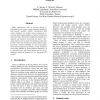Free Online Productivity Tools
i2Speak
i2Symbol
i2OCR
iTex2Img
iWeb2Print
iWeb2Shot
i2Type
iPdf2Split
iPdf2Merge
i2Bopomofo
i2Arabic
i2Style
i2Image
i2PDF
iLatex2Rtf
Sci2ools
DEXAW
2004
IEEE
2004
IEEE
Spatio-Temporal Data Warehouse Design for Human Activity Pattern Analysis
Many applications refer to moving objects or phenomena and require spatio-temporal modelling and specific analysis. Unlike conventional data where attributes are simple values (numerical or textual), object motion defines a continue variation in space and time. This makes it difficult to handle such datasets, for instance, answering the query "how many objects cross a given area during a given time period?" This article addresses spatio-temporal data warehouse schema modelling in order to facilitate those queries and more generally, on-line analytical processing (OLAP) on spatio-temporal databases. It is illustrated on a space-time human activity survey database within the framework of a European IST project1 .
Database | DEXAW 2004 | Spatio-temporal Data Warehouse | Spatio-temporal Databases | Spatio-temporal Modelling |
| Added | 20 Aug 2010 |
| Updated | 20 Aug 2010 |
| Type | Conference |
| Year | 2004 |
| Where | DEXAW |
| Authors | Lionel Savary, Tao Wan, Karine Zeitouni |
Comments (0)

